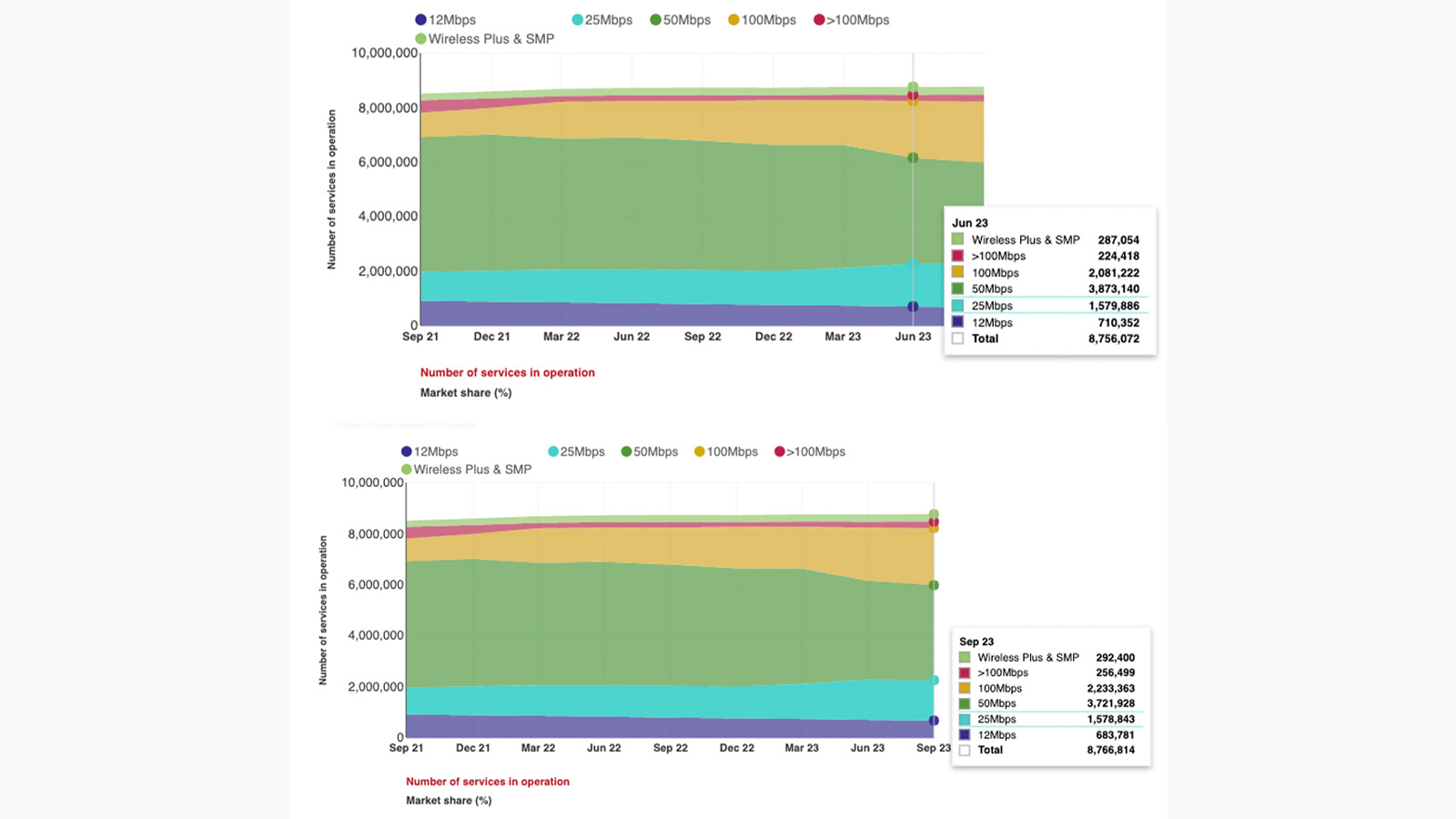Aussies are flocking to speedier NBN, with thousands ditching 50Mbps for faster plans
Latest ACCC report also shows Big 3 telcos continue to lose out to smaller providers

The Australian Competition and Consumer Commission’s (ACCC) latest quarterly report published in November, detailing the number of active residential connections across all speed tiers on the National Broadband Network (NBN), has revealed a continued drop in 50Mbps NBN 50 connections.
Amid recent NBN price hikes, the ACCC has recorded a 0.1% uptake in active residential connections, with a total of 8.76 million users connecting to the internet via a fixed-line NBN connection in Australia. Approximately 3.72 million of these are NBN 50 connections. While this means the 50Mbps plan is still the most popular in the country, the latest figure does represent a decline of around 151,000 connections since June 2023.
While the report doesn’t state why there has been a decline in NBN 50 connections, we suspect it’s partly due to the NBN’s free full fibre upgrade rollout— which allows customers who connect via fibre to the node (FTTN) or fibre to the curb (FTTC) connections, to upgrade their equipment to the much faster fibre to the premises (FTTP) connection, for free.
A stipulation of this laid out by NBN Co, is that in order to take advantage of the free upgrade, customers need to sign-up for a 100Mbps NBN 100 plan at a minimum, and must also remain connected to that plan for 12 months.
Meanwhile, NBN 100 connections saw an increase of around 152,000 — practically the same number of users who moved away from NBN 50... coincidence? That brings the total number of active connections on this speed tier to approximately 2.23 million. NBN connections on the higher-speed services — 250Mbps and 1,000Mbps — gained just over 32,000 customers.

Data also revealed that customers are continuing to walk away from the three big telcos of Telstra, TPG and Optus, and migrating to smaller NBN providers instead. When we research the best NBN plans, we often find the smaller providers offer greater value for customers, and given the current financial climate in Australia, it’s unsurprising to find customers are wanting to save money wherever possible. The ACCC report suggests collectively the three big providers lost around 87,000 customers. However, Telstra, TPG, and Optus remain as the top three telcos, with 3.58 million; 1.87 million; and 1.13 million customers, respectively.
Customer data for other individual NBN providers wasn’t provided, but is grouped together as ‘Others’. The ACCC notes that this group, alongside Vocus — the owner of Australia’s second-largest fibre network after the NBN — gained approximately 98,087 services, totalling to 2.18 million customers.
Get instant access to breaking news, the hottest reviews, great deals and helpful tips.
This would indicate that customers are becoming more aware of other NBN alternatives, such as connecting to the best 5G home internet plans or signing up to private fibre networks such as GigaComm or Opticomm, if it’s available in their area.
Australians finding greater value in high-speed plans
Given the ACCC’s report references data collected in September 2023, we do know the fluctuations would have had nothing to do with the recent price increases and decreases. We’re keen to see if the same fluctuations occur when the next report is due in roughly three months time. Our money is on the number of higher speed plans increasing even further, given their average price has now dropped.
Therefore, the uptake of faster plans could be attributed to a couple of possibilities. Our initial assumption was that more and more Aussies are partaking in the free fibre upgrade, however, an ACCC spokesperson told Tom’s Guide that “while the [NBN fibre upgrade] program has started to observe volunteers upgrading their connection to FTTP, this accounts for a relatively small proportion of our volunteers.”
They added that in the observed period, “more consumers [selected NBN 100 plans] with FTTN connections,” indicating that Australians are simply looking to improve the speed of their internet connection, perhaps to support a growing number of connected devices or simply so they can comfortably binge the best Netflix shows.
NBN 50 plans have been a long time favourite in Australia, with 50Mbps download speeds more than capable of supporting a household; but, with increases in NBN 100 plans, it seems likely that customers are reaching for more capability to stream 4K videos, play games online and do more with their internet connection.
In line with the uptake of higher speed NBN plans, the ACCC has also found that FTTP connections have also continued to increase — up from 1.86 million in June ‘23 to 1.92 million in September ‘23 — either due to installation at new properties or the aforementioned free fibre upgrade.
And lower download speeds reported for FTTN 100Mbps services “was largely driven by more consumers selecting that speed tier with FTTN connections that cannot support the maximum data rate,” the ACCC spokesperson says, adding to speculation that Australians are upgrading plans, not just their connections.
If you have yet to take advantage of the free fibre upgrade program, but you’re hankering for a faster, more stable internet connection at home, there’s a couple things you can do as a customer to get upgraded.
After performing a check to find out which NBN connection you have (both FTTN and FTTC connections are eligible), or if you’re in an area that is due for an FTTP upgrade, you will need to place an order for an NBN plan that offers speeds of 100Mbps or higher (you can check out our best NBN 100 plans here).
This is because slower plans don’t require fibre to run at their max potential, so if you elect to receive the free FTTP upgrade, you’re expected to sign up to a plan that can take advantage of it.

Lucy Scotting is a digital content writer for Tom’s Guide in Australia, primarily covering NBN and internet-related news. Lucy started her career writing for HR and staffing industry publications, with articles covering emerging tech, business and finance. In her spare time, Lucy can be found watching sci-fi movies, working on her dystopian fiction novel or hanging out with her dog, Fletcher.
